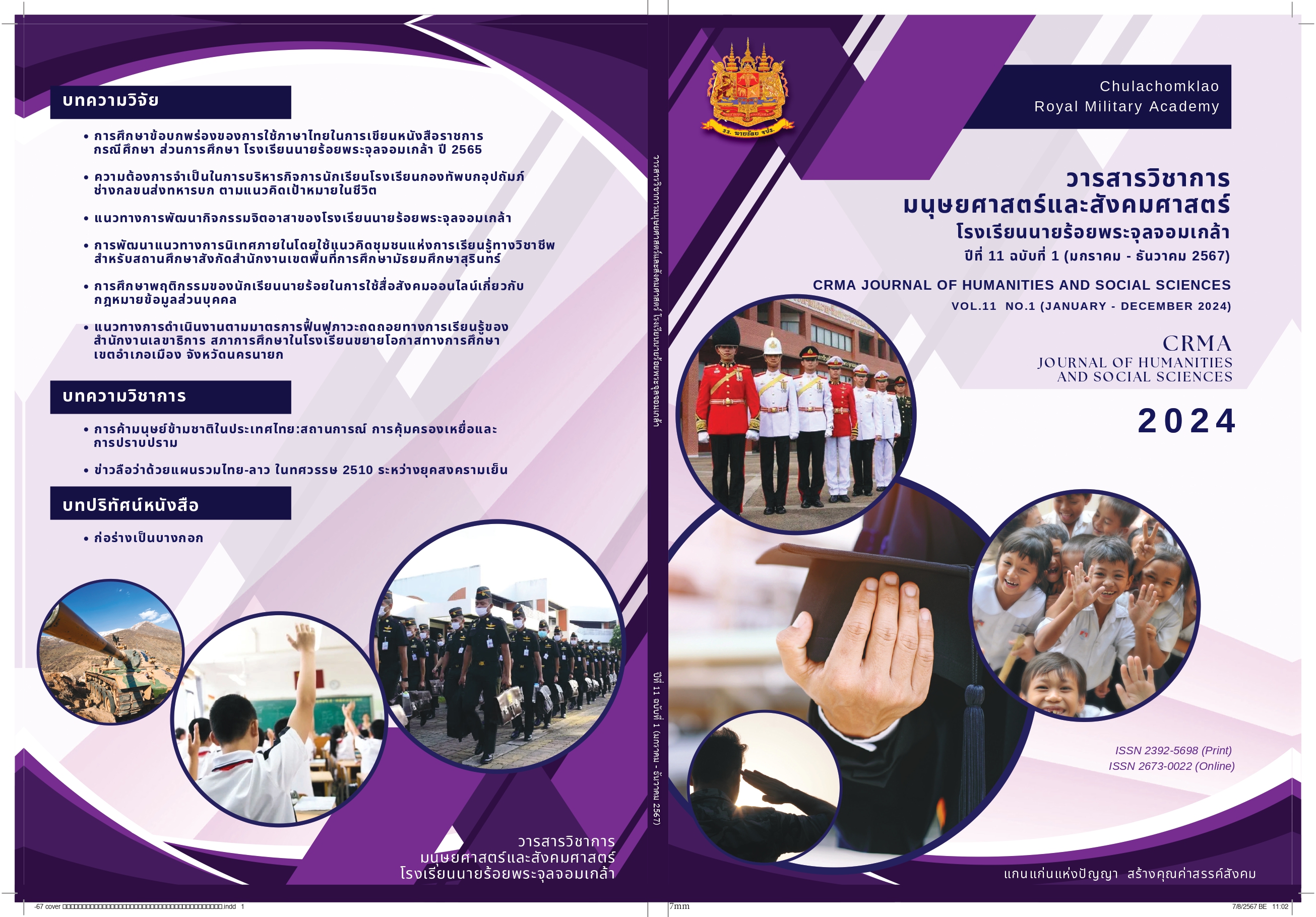The Development of Internal Supervision Guidelines using the Professional Learning Community Concept for Schools in Surin Secondary Educational Service Area
Keywords:
Guidelines Development, Internal Supervision, Professional Learning CommunityAbstract
The objectives of the research were to: 1) Study the current and desirable states, as well as the priority needs of the Internal Supervision Guidelines, using the Professional Learning Community (PLC) Concept; and 2) Develop the Internal Supervision Guidelines using the PLC Concept for Schools in Surin Secondary Educational Service Area. The study was divided into 2 phases. The sample population was 454 administrators and teachers, which was derived by stratified random sampling. The research tools were: 1) A set of questionnaires; 2) An interview form; and 3) A guidelines assessment form. The data were analyzed via the calculations of frequency, percentage, mean, and standard deviation. The results of this study were: 1) The current state of the Internal Supervision Guidelines using the PLC Concept for Schools overall was at a high level and the desirable state of the Internal Supervision Guidelines using the PLC Concept for Schools overall was at the highest level. The Priority Needs Index of the Internal Supervision Guidelines as ordered from the highest to lowest needs were as follows: the study of current problems and needs of internal supervision, planning of internal supervision, implementation of internal supervision, the reflection, report, and dissemination of internal supervision results, and evaluation, monitoring, and improvement of internal supervision work; and 2) The Internal Supervision Guidelines using the PLC Concept for Schools consists of 30 guidelines. The results of the suitability and feasibility assessment of the Internal Supervision Guidelines found that the guidelines were appropriate at the highest level and overall feasibility was at the highest level.
References
กรองทอง จิรเดชากุล. (2550). คู่มือการนิเทศภายในโรงเรียน. ธารอักษร.
ทิศนา แขมมณี. (2559). ศาสตร์การสอน: องค์ความรู้เพื่อกระบวนการจัดการเรียนรู้ที่มีประสิทธิภาพ (พิมพ์ครั้งที่ 20). สํานักพิมพ์จุฬาลงกรณ์มหาวิทยาลัย.
ธัญพิชชา อุ่นรัมย์. (2564). การพัฒนาแนวทางการนิเทศภายในแบบสอนแนะโดยใช้แนวคิดชุมชนแห่งการเรียนรู้เชิงวิชาชีพ สำหรับสถานศึกษาในสังกัดสานักงานเขตพื้นที่การศึกษามัธยมศึกษา เขต 33. [วิทยานิพนธ์ปริญญามหาบัณฑิต ไม่ได้ตีพิมพ์]. มหาวิทยาลัยมหาสารคาม.
บุญชม ศรีสะอาด. (2553). การวิจัยเบื้องต้น (พิมพ์ครั้งที่ 8). สุวีริยาสาส์น.
วรรณภา ธรรมขันธ์. (2561). แนวทางการพัฒนาการนิเทศภายในโดยใช้แนวคิดชุมชนแห่งการเรียนรู้ทางวิชาชีพสำหรับสถานศึกษาสังกัดสำนักงานเขตพื้นที่การศึกษามัธยมศึกษา เขต 21. [วิทยานิพนธ์ปริญญามหาบัณฑิต ไม่ได้ตีพิมพ์]. มหาวิทยาลัยมหาสารคาม.
วรลักษณ์ ชูกำเนิด. (2564). การวิเคราะห์องค์ประกอบเชิงยืนยันของการเป็นชุมชนแห่งการเรียนรู้ทางวิชาชีพของโรงเรียนสังกัดสำนักงานเขตพื้นที่การศึกษาประถมศึกษาในสามจังหวัด ชายแดนภาคใต้. วารสารศึกษาศาสตร์ มหาวิทยาลัยสงขลานครินทร์ วิทยาเขตปัตตานี, 32(1), 50-60.
วัชรา เล่าเรียนดี. (2553). การนิเทศการสอน สาขาวิชาหลักสูตรและการนิเทศ. โรงพิมพ์มหาวิทยาลัยศิลปากร.
วิจารณ์ พานิช. (2554). วิถีสร้างการเรียนรู้เพื่อศิษย์ในศตวรรษที่ 21. ตถาตาพลับลิเคชั่น.
สำนักงานเขตพื้นที่การศึกษามัธยมศึกษาสุรินทร์. (2565). รายงานการประเมินตนเอง (SAR) สำนักงานเขตพื้นที่การศึกษามัธยมศึกษาสุรินทร์ ประจำปี 2565. สำนักงานเขตพื้นที่การศึกษามัธยมศึกษาสุรินทร์.
สำนักงานคณะกรรมการการศึกษาขั้นพื้นฐาน. (2553). พระราชบัญญัติการศึกษาแห่งชาติ พ.ศ.2542 และที่แก้ไข เพิ่มเติม (ฉบับที่ 3). สำนักนายกรัฐมนตรี.
สำนักงานคณะกรรมการพัฒนาการเศรษฐกิจและสังคมแห่งชาติ. (2562). ยุทธศาสตร์ชาติระยะ 20 ปี (พ.ศ. 2561-2580) (พิมพ์ครั้งที่ 2). สำนักงานเลขานุการของคณะกรรมการยุทธศาสตร์ชาติ สำนักงานคณะกรรมการพัฒนาการเศรษฐกิจและสังคมแห่งชาติ.
สำนักงานเลขาธิการสภาการศึกษา. (2560). กรอบคุณวุฒิแห่งชาติ = National Qualifications Framework (Thailand NQF) /สำนักงานเลขาธิการสภาการศึกษา กระทรวงศึกษาธิการ. สำนักงานเลขาธิการสภาการศึกษา.
Krejcie, R.V., & Morgan, D.W. (1970). “Determining Sample Size for Research Activities”. Educational and Psychological Measurement.
Downloads
Published
How to Cite
Issue
Section
Categories
License
Copyright (c) 2024 CRMA Journal of Humanities and Social Sciences

This work is licensed under a Creative Commons Attribution-NonCommercial-NoDerivatives 4.0 International License.
The content and information in this journal shall be considered as the individual opinions of the authors. In all cases, the editorial board may not necessarily agree with these opinions or be responsible for them.
The articles and information that are published in the journal are considered to be the copyright of the journal. Any party who wishes to re-publish the journal’s articles must seek permission from the journal’s editor. Articles that receive the agreement for publications must not appear in any other publications prior to their appearance in this journal. The editorial board will send one copy of the journal to each author whose submission was accepted and published.







